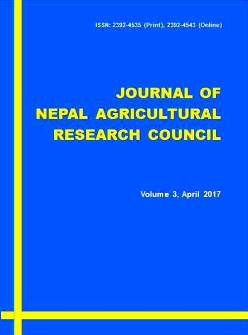Effect of Sucrose and Growth Regulator’s Level on Ginger Micropropagation
DOI:
https://doi.org/10.3126/jnarc.v3i1.17275Keywords:
Ginger, Zingiber officinale, In-vitro rhizome, Sucrose, NAA, BA, MicropropagationAbstract
Ginger is most important cash crop of the hilly region of Nepal. However, availability of disease free planting material (rhizome) is the major problem faced by Nepalese farmers. Tissue culture is the only option to produce disease free rhizome of ginger. Suitable culture media combination is most important for the production of planting material in ginger through tissue culture. Therefore, effect of different level of sucrose and growth regulators on micro-propagation of ginger was studied using local collection ‘Kaski Local’. Early stage bud was used as explant. MS basal media with different level of sucrose and growth regulators was used as tissue culture media. 30 g/L sucrose, 30 g/L sucrose+5mg/L BA, 30 g/L sucrose+5 mg/L BA+0.5 mg/L NAA, 60 g/L sucrose+5mg/L BA, 60 g/L sucrose+5 mg/L BA+0.5mg/L NAA, 90 g/L sucrose+5 mg/L BA was used in this study. The explants were surface sterilized, cultured and incubated at 25±2°C, 90-95% relative humidity and 14:10 hours light:dark photoperiod for 8 weeks. Increased level of the sucrose increased the rhizome weight, however, addition of NAA produced more positive effect for this. MS basal media with 60 g/L sucrose+5 mg/L BA+0.5 mg/L NAA produced higher rhizome weight.
Journal of Nepal Agricultural Research Council Vol.3 2017: 45-48
Downloads
1067
2130




